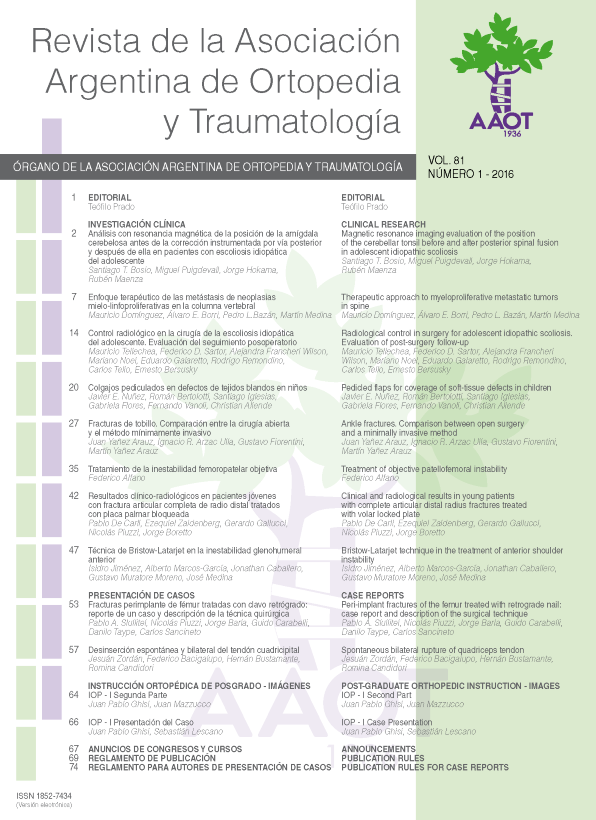Peri-implant fractures below a sliding hip screw treated with retrograde nailing: a case report and description of surgical technique
Main Article Content
Abstract
Downloads
Metrics
Article Details

This work is licensed under a Creative Commons Attribution-NonCommercial-ShareAlike 4.0 International License.
Manuscript acceptance by the Journal implies the simultaneous non-submission to any other journal or publishing house. The RAAOT is under the Licencia Creative Commnos Atribución-NoComercial-Compartir Obras Derivadas Igual 4.0 Internacional (CC-BY-NC.SA 4.0) (http://creativecommons.org/licences/by-nc-sa/4.0/deed.es). Articles can be shared, copied, distributed, modified, altered, transformed into a derivative work, executed and publicly communicated, provided a) the authors and the original publication (Journal, Publisher and URL) are mentioned, b) they are not used for commercial purposes, c) the same terms of the license are maintained.
In the event that the manuscript is approved for its next publication, the authors retain the copyright and will assign to the journal the rights of publication, edition, reproduction, distribution, exhibition and communication at a national and international level in the different databases. data, repositories and portals.
It is hereby stated that the mentioned manuscript has not been published and that it is not being printed in any other national or foreign journal.
The authors hereby accept the necessary modifications, suggested by the reviewers, in order to adapt the manuscript to the style and publication rules of this Journal.
References
2. Kannus P, Parkkari J, Sievänen H, Heinonen A, Vuori I, Järvinen M. Epidemiology of hip fractures. Bone. 1996;18(1 Suppl):57S-63S.
3. Giannoudis P V, Schneider E. Principles of fixation of osteoporotic fractures. J Bone Joint Surg Br. 2006;88(10):1272-8. doi:10.1302/0301-620X.88B10.17683.
4. Antes DL, Hallal PC. Quedas e fraturas entre residentes de instituições de longa permanência para idosos [Falls and fractures among older adults living in long-term care]. Rev Bras Epidemiol. 2013;16(1):68-76.
5. Lloyd BD, Williamson DA, Singh NA, et al. Recurrent and injurious falls in the year following hip fracture: a prospective study of incidence and risk factors from the Sarcopenia and Hip Fracture study. J Gerontol A Biol Sci Med Sci. 2009;64(5):599-609. doi:10.1093/gerona/glp003.
6. Formiga F, Navarro M, Duaso E, et al. Factors associated with hip fracture-related falls among patients with a history of recurrent falling. Bone. 2008;43(5):941-4. doi:10.1016/j.bone.2008.06.014.
7. Swinteck BJ, Phan DL, Jani J, Owen JR, Wayne JS, Mounasamy V. Biomechanical effects of hardware configuration after union of proximal femoral and shaft fractures. Bone Joint Res. 2012;1(6):104-10. doi:10.1302/2046-3758.16.2000067.
8. Erhart S, Kammerlander C, El-Attal R, Schmoelz W. Is augmentation a possible salvage procedure after lateral migration of the proximal femur nail antirotation? Arch Orthop Trauma Surg. 2012;132(11):1577-81. doi:10.1007/s00402-012-1579-3.
9. Erhart S, Schmoelz W, Blauth M, Lenich A. Biomechanical effect of bone cement augmentation on rotational stability and pull-out strength of the Proximal Femur Nail AntirotationTM. Injury. 2011;42(11):1322-7. doi:10.1016/j.injury.2011.04.010.
10. Vidyadhara S, Rao SK. Cephalomedullary nails in the management of ipsilateral neck and shaft fractures of the femur--one or two femoral neck screws? Injury. 2009;40(3):296-303. doi:10.1016/j.injury.2008.08.009.
11. Jain P, Maini L, Mishra P, Upadhyay A, Agarwal A. Cephalomedullary interlocked nail for ipsilateral hip and femoral shaft fractures. Injury. 2004;35(10):1031-8. doi:10.1016/j.injury.2003.09.039.
12. Anup K, Mehra MM. Retrograde femoral interlocking nail in complex fractures. J Orthop Surg (Hong Kong). 2002;10(1):17-21.
13. Oh C-W, Oh J-K, Park B-C, et al. Retrograde nailing with subsequent screw fixation for ipsilateral femoral shaft and neck fractures. Arch Orthop Trauma Surg. 2006;126(7):448-53. doi:10.1007/s00402-006-0161-2.
14. Zuurmond RG, Pilot P, Verburg a D. Retrograde bridging nailing of periprosthetic femoral fractures. Injury. 2007;38(8):958-64. doi:10.1016/j.injury.2006.12.011.
15. Parvizi J, Rapuri VR, Purtill JJ, Sharkey PF, Rothman RH, Hozack WJ. Treatment protocol for proximal femoral periprosthetic fractures. J Bone Joint Surg Am. 2004;86-A Suppl:8-16.
16. Harris T, Ruth JT, Szivek J, Haywood B. The effect of implant overlap on the mechanical properties of the femur. J Trauma. 2003;54(5):930-5. doi:10.1097/01.TA.0000060999.54287.39.

